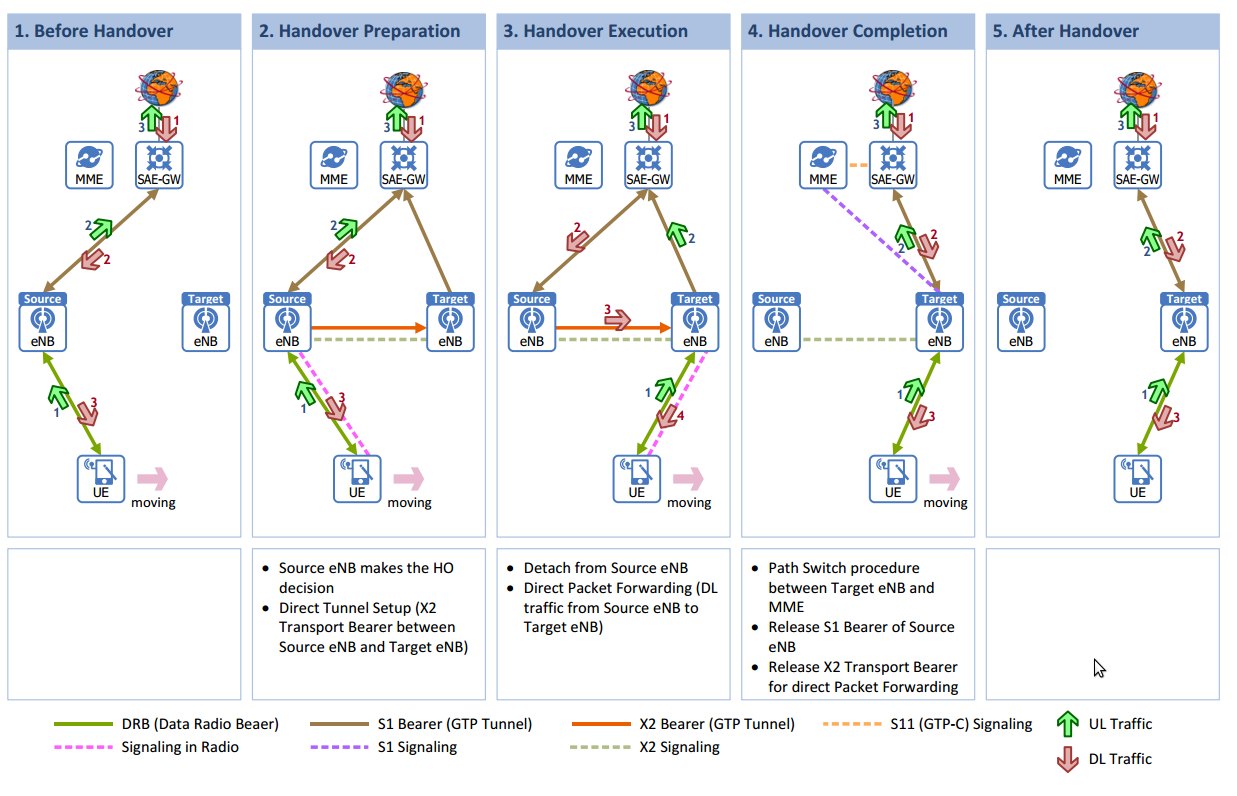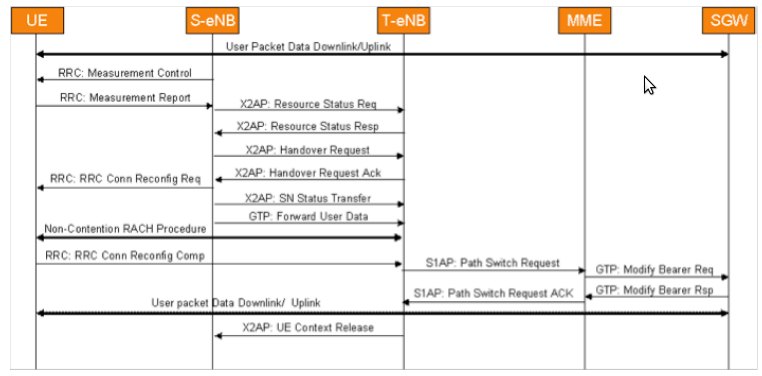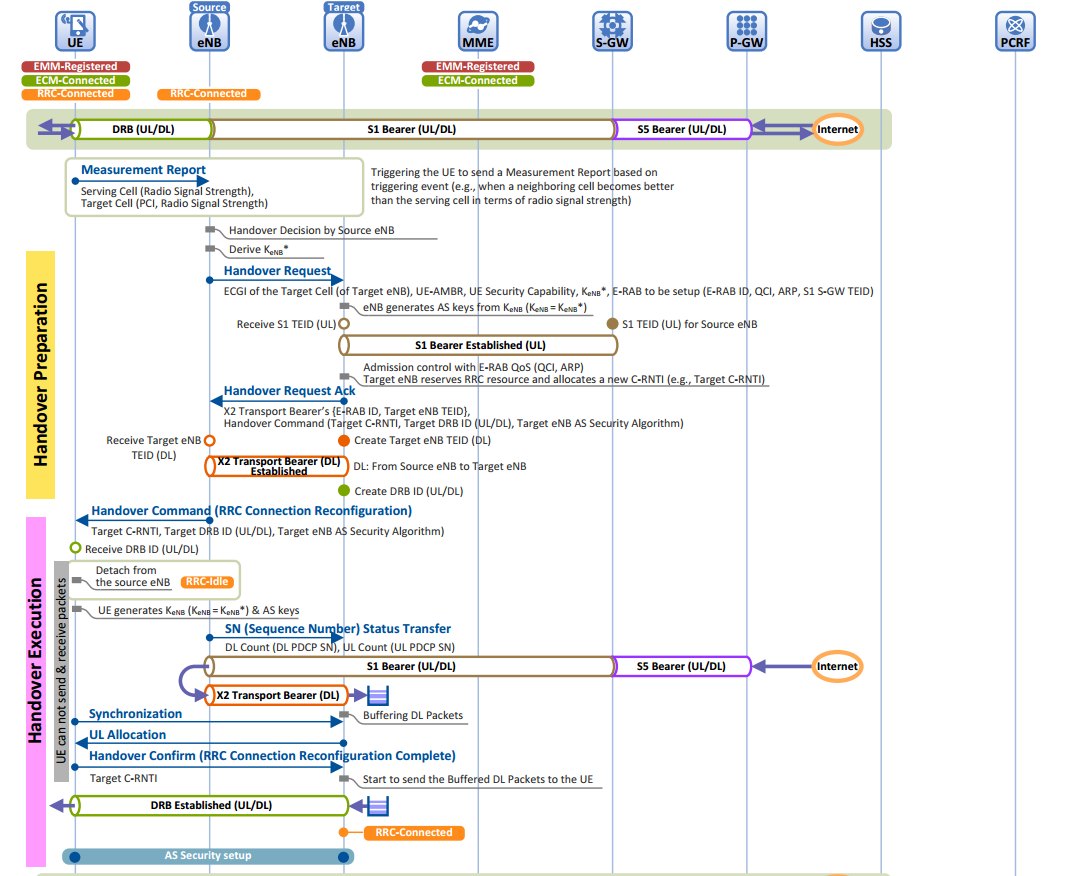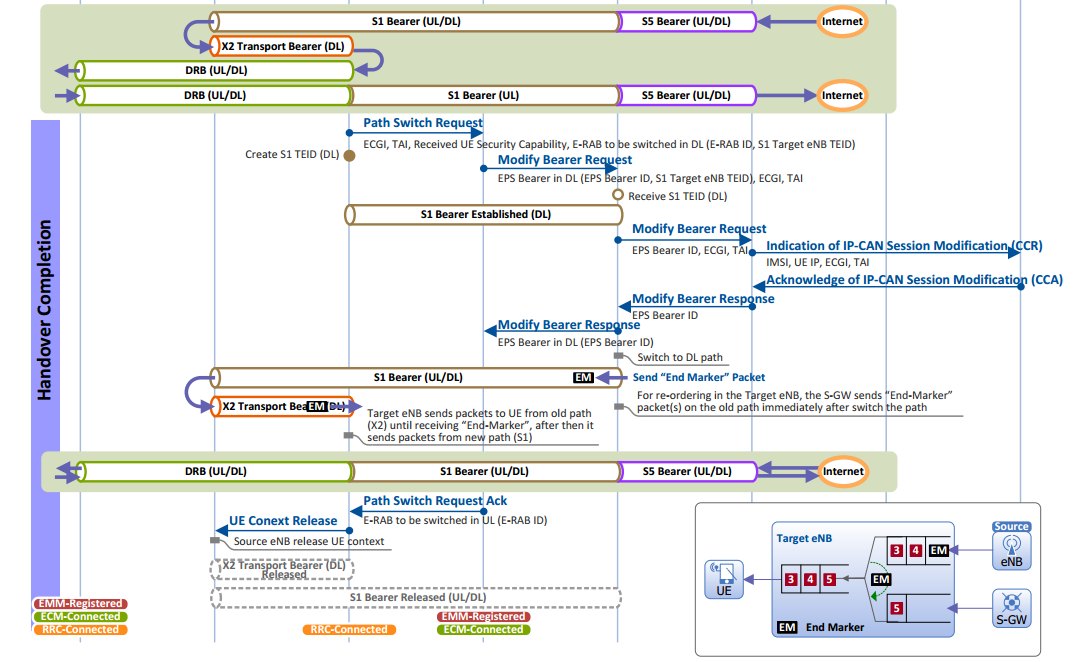Intra-LTE (Intra-MME/SGW) handover using the X2 interface is used to handover a UE from a source eNodeB (S-eNB) to a target eNodeB (T-eNB) using the X2 interface when the Mobility Management Entity (MME) and Serving Gateway (SGW) are unchanged.
This scenario is possible only when there is a direct connection exists between source eNodeB and target eNodeB with the X2 interface.
Intra-LTE Handover Using the X2 Interface System Architecture
In case of intra-LTE handover using X2 interface the UE is source eNodeB and is in connected stated and the goal is to move the UE to target eNodeB. The X2 handover procedure is performed without Evolved Packet Core (EPC) involvement, i.e. preparation messages are directly exchanged between the S-eNB and T-eNB. The release of the resources at the source
side during the handover completion phase is triggered by the T-eNB.
Call Flow for Intra-LTE Handover
Intra-LTE Handover Call Flow Description
- UE is in connected state and a data call is up. Data packets are transferred to/from the UE to/from the network in both directions (DL as well as UL).
- The network sends the MEASUREMENT CONTROL REQ message to the UE to set the parameters to measure and set thresholds for those parameters. Its purpose is to instruct the UE to send a measurement report to the network as soon as it detects the thresholds.
- The UE sends the MEASUREMENT REPORT to the S-eNB after it meets the measurement report criteria communicated previously. The S-eNB makes the decision to hand off the UE to a T-eNB using the handover algorithm; each network operator could have its own handover algorithm.
- The S-eNB issues the RESOURCE STATUS REQUEST message to determine the load on T-eNB (this is optional). Based on the received RESOURCE STATUS RESPONSE, the S-eNB can make the decision to proceed further in continuing the handover procedure using the X2 interface.
- The S-eNB issues a HANDOVER REQUEST message to the T-eNB passing necessary information to prepare the handover at the target side (e.g., UE Context which includes the Security Context and RB Context (including E-RAB to RB Mapping) and the Target cell info).
- The T-eNB checks for resource availability and, if available, reserves the resources and sends back the HANDOVER REQUEST ACKNOWLEDGE message including a transparent container to be sent to the UE as an RRC message to perform the handover. The container includes a new C-RNTI, T-eNB security algorithm identifiers for the selected security algorithms, and may include a dedicated RACH preamble and possibly some other parameters (i.e., access parameters, SIBs, etc.).
- The S-eNB generates the RRC message to perform the handover, i.e, RRCCONNECTION RECONFIGURATION message including the mobilityControlInformation. The S-eNB performs the necessary integrity protection and ciphering of the message and sends it to the UE.
- The S-eNB sends the eNB STATUS TRANSFER message to the T-eNB to convey the PDCP and HFN status of the E-RABs.
- The S-eNB starts forwarding the downlink data packets to the T-eNB for all the data bearers (which are being established in the T-eNB during the HANDOVER REQ message processing).
- In the meantime, the UE tries to access the T-eNB cell using the non-contention-based Random Access Procedure. If it succeeds in accessing the target cell, it sends the RRC CONNECTION RECONFIGURATION COMPLETE to the T-eNB.
- The T-eNB sends a PATH SWITCH REQUEST message to the MME to inform it that the UE has changed cells, including the TAI+ECGI of the target. The MME determines that the SGW can continue to serve the UE.
- The MME sends a MODIFY BEARER REQUEST (eNodeB address and TEIDs for downlink user plane for the accepted EPS bearers) message to the SGW. If the PDN GW requested the UE’s location info, the MME also includes the User Location Information IE in this message.
- The SGW sends the downlink packets to the target eNB using the newly received addresses and TEIDs (path switched in the downlink data path to T-eNB) and the MODIFY BEARER RESPONSE to the MME.
- The SGW sends one or more “end marker” packets on the old path to the S-eNB and then can release any user plane / TNL resources toward the S-eNB.
- The MME responds to the T-eNB with a PATH SWITCH REQ ACK message to notify the completion of the handover.
- The T-eNB now requests the S-eNB to release the resources using the X2 UE CONTEXT RELEASE message. With this, the handover procedure is complete.
Complete Detail of Intra-LTE Handover procedure using X2 interface
Referances
- LTE X2 Handover PDF
- 3GPP TS 36.423: “Evolved Universal Terrestrial Radio Access Network (E-UTRAN); X2 Application Protocol (X2AP).”
- 3GPP TS 25.331: “UMTS Radio Resource Control (RRC) Protocol specification.”





Permalink
Permalink
Permalink
please change the 8 th point sn status transfer message in place of enb configuration update message
Permalink
Very good explanation, I am reading ur block from couple of month I like the way explain each thing very clearly.
Can u tell me if operator using two carrier frequency that is one is 2300 band second one is 1800 band then how user equipment do the inter frequency handover in LTE..
Awaiting for ur reply..
U can reply on mail